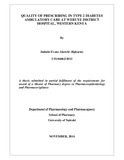| dc.description.abstract | Background
:
Diabetes mellitus is a chronic metabolic disorder that is of great public health
importance
globally
.
Type 2 diabetes
accounts for 90
% of all diabetes
.
Lifestyle
interventions are promoted as the initial management approaches
in type 2 diabetes
but are
known
to provide optimal results
in
only
a minority of patients.
Pharmacological
interventions therefore remain the mainstay approach. Many classes of
glucose lowering
drugs are
available, increasing treatment options from which choices can be made.
Quality
prescribing
of these drugs
is recommended as it
results in
greater improvement in glycaemic
control, blood pressure and lipid management.
However,
i
n most practices
, quality of
prescribing is
rarely monitored, thereby compromising qu
ality of diabetic care. Prescribing
quality
indicators, quality indicators
and criteria have been developed to monitor quality
of
prescribing.
Objective
:
The
main
objec
tive of this study was to
investigate
the
quality of prescribing in
type 2 diabetes mellitus
ambulatory care at Webuye District Hospital.
Methodology
:
This was
a
retrospective
review of patient medical records
at
Webuye District
Hospital,
Western
Kenya.
The target population was t
ype 2
diabetes mellitus
p
atients who
visited the diabetic clinic in the year 2013.
Fisher’s formula for descriptive st
udies
was used
to calculate
a
sample of
369
patients.
Sequential
sa
mpling
of
patient attendance lists
was
applied to retrieve
880 patient
records
and the
first
369
that met the
inclusion criteria were
picked for this study.
A
data
collection form
was designed, p
re
-
tested
and validated.
D
ata
collected
were coded
and analysed with
Microsoft Office E
xcel
2007
and
STATA
®
software
version 10.
1.
Bivariate and multivariate
logistic
regression was
used to determine factors
influencing prescription of specific drugs.
Results
:
Of the total
369
type 2 diabetes mellitus
patients,
57.2 %
were female
s while
14.9
%
were newly diagnosed
. The main co
-
morbid
ity was hypertension
, affecting
70.5 % of the
patients. The
main drugs
prescribed fo
r hyperglycemia
were metformin (
84.9 %),
glibenclamide (47.7 %) and insulin (
32.0 %) while
those
prescribed for
cardiovascular risk
were
hydrochlo
rothiazide (
52.8 %) and enalapril (51.8 %)
.
More than 89
.0
% of
patients with
hypertension were prescribed enalapril or losartan, which represented good quality
prescribing.
Potential cases of drug
-
drug interact
ions were found in 4 % (95 % CI
:
2
-
6)
of
records
reviewed
, representing good quality prescribing Age, weight and systolic blood pressure
were re
corded for all 369 patients
.
B
ody mass index
was recorded
for
56 %
patients while
albuminuria was not recorded for any of the patients
.
Outcomes for
10
of
the
12 selected
prescribing quality indicators
varied from
99 % for
prescribing
any antihyperglycaemic or antihypertensive medication
to
6 % for prescribing
statin
s
in
patien
ts with high cardiovascular risk to
.
Outcome
s
for the remaining 2
indicators
could not be calculated due to absence of eligible patients.
The use of insulin was
significantly
influenced by glycated haemoglobin
[Odds ratio (OR)
1.2
,
p
<
0.01]
and duration of diabetes
(OR
1.1
, p
<
0.01)
while the use of losartan or
enalapril was
significantly
influenced by
h
ypertension
(OR 19.3,
p
<
0.01
)
. Additionally, use
of acetyl salicylic acid was
significantly
influenced by
hypertension (OR 4.1,
p
<
0.01
) and
age (
OR 1.1, p
<
0.01
).
Conclusion:
This study established that
there was a high rate of
a
dherence to
treatment
guidelines on
choice of drugs for management of hyperglycemia an
d cardiovascular risk
,
which represented
good
quality prescribing
. However, there were deficiencies
in adequate
cont
rol of hyperglycemia, hypertension and dyslipidaemia.
Outcomes for 6
prescribing
quality indicators
represented good quality prescribing, whil
e
outcomes for
4 others
represented poor quality prescr
ibing. There were also deficiencies
in
quality of prescribing in
elderly
patients,
where nearly half were prescribed
glibenclamide;
whi
le only one third were
prescribed
acetyl salicylic acid
for primary prevention of cardiovascular disease
. Cases of
potential
drug
-
dru
g interactions were below
5
%
,
which represented
good
quality prescribing
.
Glycated hemoglobin
level and duration of diabetes
significantly
influenced
use
of insulin
while
hypertension
significantly
influenced
use of enalapril, losartan and acetyl salicylic acid.
Age also significantly influenced use of acetyl salicylic acid.
Findings from this study
provide a framework for policy makers
at the Ministry of Health in Kenya
to formulate
strategies to promote
pharmacotherapy outcomes in type
2
diabetes in particular
and other
chronic diseases in general | en_US |

